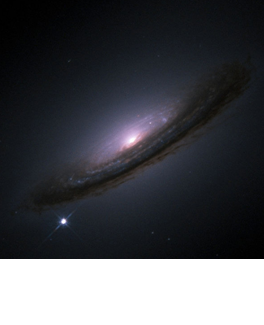- 1610: Galileo
- 1676: Ole Rømer
- 1687: Isaac Newton
- 1781: William Herschel
- 1838: Friedrich Bessel
- 1861: William and Margaret Huggins
- 1912: Henrietta Leavitt
- 1917 Einstein
- 1920: Harlow Shapley
- 1929 Edwin Hubble
- 1948: Ralph Alpher
- 1949: Fred Hoyle
- 1963: Maarten Schmidt
- 1964: Arno Penzias and Robert Wilson
- 1978: Vera Rubin and Kent Ford
- 1989: Margaret Geller and John Huchra
- 1992: John Mather and George Smoot
- 1995: Robert Williams
- 1998: Saul Perlmutter and Brian Schmidt
- 2010: Wendy Freedman
Type 1A Supernovae
 Supernovae are among the most brilliant objects in the universe, outshining the light of all the stars in their host galaxy for a short time. A supernova occurs when a white dwarf star attracts large amounts of matter from a companion star or disk of material. This may happen when a nearby star swells to the red giant stage. Matter continues falling on the white dwarf until it reaches 1.38 solar masses, and then it explodes into a supernova.
Supernovae are among the most brilliant objects in the universe, outshining the light of all the stars in their host galaxy for a short time. A supernova occurs when a white dwarf star attracts large amounts of matter from a companion star or disk of material. This may happen when a nearby star swells to the red giant stage. Matter continues falling on the white dwarf until it reaches 1.38 solar masses, and then it explodes into a supernova. Type 1A's are not all the same luminosity, but like Cepheids, the faster ones are dimmer, so we can figure out how intrinsically luminous they are by seeing how fast they vary (although they don't stick around like Cepheids). That enabled both teams to measure the distance to each supernova. Distance is also an indicator of time since we observe a supernova 5 billion light years away as it appeared 5 billion years ago. They also measured the Supernova’s red shift to determine how fast the universe was expanding at that time. The amazing result is that the expansion of the universe is not slowing due to gravity. It is now expanding faster than in the past. Some unseen force must be causing the accelleration. This is unknown force is called “dark energy.”
Type 1A's are not all the same luminosity, but like Cepheids, the faster ones are dimmer, so we can figure out how intrinsically luminous they are by seeing how fast they vary (although they don't stick around like Cepheids). That enabled both teams to measure the distance to each supernova. Distance is also an indicator of time since we observe a supernova 5 billion light years away as it appeared 5 billion years ago. They also measured the Supernova’s red shift to determine how fast the universe was expanding at that time. The amazing result is that the expansion of the universe is not slowing due to gravity. It is now expanding faster than in the past. Some unseen force must be causing the accelleration. This is unknown force is called “dark energy.”
The result of these findings is that we know less about the universe than we thought we did. Thanks to these findings and the WMAP satellite data, we now know that:
- Only 4% of the mass in the universe is visible as stars and galaxies.
- About 23% of the universe is “dark matter.”
- About 72% of the universe is dark energy, accelerating the expanding universe.